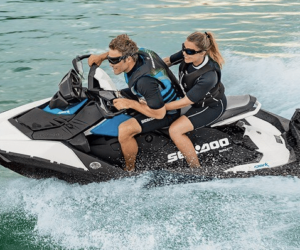Sailing in storms: tips for navigating safely in bad weather

1. the right preparation
Preparation is the key to safe sailing in a storm. This includes both the technical inspection of the boat and the training of the crew.
Check boat equipment
Before heading out into stormy weather, you should make sure that your boat is in perfect condition. Check:
- Rig and rigging: Ensure that the rig and rigging are secure and well tensioned to withstand the stresses of strong winds.
- Sails: Use smaller, heavy-duty sails. Reef early to keep the boat stable.
- Safety equipment: Make sure that all safety equipment such as life jackets, safety lines, EPIRB (Emergency Position Indicating Radio Beacon) and emergency rockets are present and in working order.
Prepare crew
The crew must be both mentally and physically prepared for sailing in a storm. Practise manoeuvres such as reefing the sails, hoisting the storm sail and how to behave in man-overboard situations in advance.
2. Interpreting weather forecasts correctly
Understanding and interpreting weather forecasts is essential to making decisions about when to return to harbour or how to avoid the worst of the storm.
Check weather reports regularly
Use reliable weather services and check the reports regularly. Pay particular attention to:
- Wind speed and direction: Know what wind forces your boat can withstand and plan accordingly.
- Wave heights: High waves can be particularly dangerous if they come from the side.
- Fronts and thunderstorms: Fronts can appear suddenly and drastically worsen the weather. Avoid sailing near them.
Recognising signs of an approaching storm
Even if the forecasts are good, you should always keep your eyes open for signs of an approaching storm, such as dark clouds, sudden wind changes or falling air pressure.
3. Correct sail setting in a storm
Setting the right sails is crucial to maintaining control of the boat and minimising the load on the structure.
Storm jib and trysail
Use storm jibs and trysails in strong winds. These are specially designed to keep the boat stable while reducing the sail area as much as possible.
Reefing
Reef your sails early. A fully extended sail can become uncontrollable in strong winds and cause the boat to capsize. Smaller, well-reefed sails ensure better stability and manoeuvrability.
4. manoeuvres in heavy weather
Sailing in stormy weather requires special manoeuvres that help to ensure safety on the water.
Shooting up and mooring
If the storm becomes too strong, it can be useful to let the boat shoot up or lie alongside. Both manoeuvres help to bring the boat into a safe position in which it is less affected by the waves and wind.
Sailing with the wind
When sailing downwind, the ride can be smoother as the boat rides the waves. However, be careful not to lose control and avoid the waves rolling over onto the deck.
5. Crew safety
The safety of the crew has top priority. Especially in heavy weather conditions, it is important that everyone on board is well secured.
Safety lines and harnesses
Every crew member should always be on a leash in heavy weather. The safety lines prevent anyone from going overboard if the boat heels heavily or a large wave washes over the deck.
Wear life jackets
Regardless of the crew’s experience, everyone should wear a lifejacket in stormy weather. This can save lives in an emergency, especially if a crew member goes overboard.
6. Behaviour in the event of man overboard
A ‘man overboard’ manoeuvre is particularly risky in bad weather. Practise this manoeuvre in advance and define clear roles for the crew so that everyone knows what to do in an emergency.
Immediate measures
As soon as someone has gone overboard, the alarm should be sounded immediately and a buoy thrown to mark the position. Turn the boat slowly and in a controlled manner so as not to lose visual contact.
Rescue manoeuvre
If possible, haul in the crew member who has gone overboard from the windward side to protect them from waves. Use safety belts to get the person back on board.
Our summary
Sailing in storms requires careful preparation, the right equipment and a well-trained crew. With the right attitude and the tips mentioned above, you can sail safely even in difficult conditions. It is important to assess the situation correctly and, if necessary, play it safe by seeking shelter in a harbour.
















